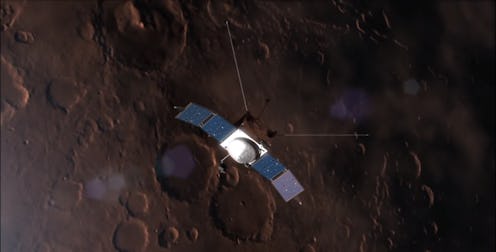News
10 Months Later, This Just Arrived At Mars

NASA may be reconfiguring its whole astronaut program, but that hasn't taken away from the space agency's nonhuman-piloted expeditions. On Sunday evening, the NASA MAVEN spacecraft entered the Mars orbit, an astronomical feat considering it took roughly 10 months of traveling 442 million miles to get there. But the robotic spacecraft, which now joins several other satellites floating through Mars' orbit, is only just beginning its mission.
According to NASA, MAVEN, which stands for Mars Atmosphere and Volatile Evolution, will be the first spacecraft to explore the Red Planet's thin upper atmosphere in full detail. This mission was 11 years in the making, with MAVEN jetting off from the Earth in November 2013.
Bruce Jakosky, principal investigator for MAVEN, said in a NASA news release that this one-of-a-kind mission will help scientists better understand the climate and atmosphere of Mars:
We’re the first mission devoted to observing the upper atmosphere of Mars and how it interacts with the sun and the solar wind. ... MAVEN’s orbit through the tenuous top of the atmosphere will be unique among Mars missions. We’ll get a new perspective on the planet and the history of the Martian climate, liquid water and planetary habitability by microbes.
So, how does this all work now that MAVEN has arrived in Mars' orbit? NASA said the spacecraft will begin a "six-week commissioning phase" that will drop MAVEN into the planet's "science orbit." This will put the spacecraft just 77 miles above the planet's surface, allowing NASA scientists to fully study the Martian atmosphere. After that, MAVEN will begin its last mission phase, which will last about one year.
Do the scientists hope to catch something on this mission, such as signs of life outside Earth? It's certainly a possibility. "Maven will complement NASA's other Martian robotic explorers ... to answer some fundamental questions about Mars and life beyond Earth," said NASA astronaut and Science Mission Directorate administrator John Grunsfeld.
NASA Administrator Charles Bolden added that the MAVEN mission could answer some questions we have about one day sending humans to the Red Plant by the 2030s. A trip to the Mars Colony, anyone?
Bolden said:
As the first orbiter dedicated to studying Mars' upper atmosphere, MAVEN will greatly improve our understanding of the history of the Martian atmosphere, how the climate has changed over time, and how that has influenced the evolution of the surface and the potential habitability of the planet.
By studying Mars' upper atmosphere, Jakosky added at a recent news conference that the new data will show whether or not life is truly sustainable on the planet. "Any life on Mars interacts with its planetary environment; we need to know what that environment is," Jakosky said.
With the arrival of MAVEN, Mars is getting pretty crowded. The planet's orbit is already home to NASA's Mars Odyssey spacecraft and Mars Reconnaissance Orbiter (MRO), and the European Space Agency's Mars Express. Two robotic land rovers are already combing the Mars surface. India's first Mars probe, the Mars Orbiter Mission, is also expected to reach the planet by Tuesday.
Images: NASA